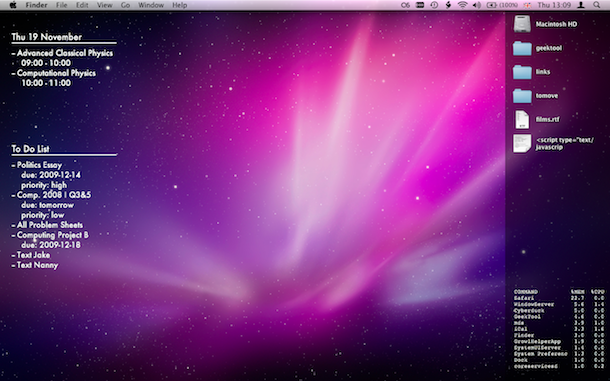

the last part (&id=2220) specifies what data feed you want to get the last value of. The URL starting with ’’ is the part that gets the data, using a unique API key for authentication. Now I’m not going to pretend I know the inner workings of shell script, so I’ll just point out which bits do what. But since it was basically a simple URL that returned the data, I thought it must be possible to incorporate it into Geektool.
#GEEKTOOL SCRIPT HOW TO#
I found this little nugget of information in an example sketch for the nanodeRF, (these devices are programmed using the Arduino environment) showing how to poll the server with the device itself, useful for sending control messages to other connected devices perhaps. Graphs and dials for Power and Temperature Head over to their site for more info on these. The external one is connected to an emontx unit from and the room one is on the emonGLCD. Now, the ‘external’ and ‘room’ temperatures actually come from my own sensors. The script then simply copies the correct image to a pre-defined file and location, which you can then display as an image geeklet. The Realfeel and the little graphic showing the current conditions use a ruby script by Ted Wise and, as with the overlay, I created a different image for each weather condition, using the default accuweather set as a guide. I won’t cover the clock part as that’s pretty easily googleable. Then you just select the custom font in the geeklet settings. To get the circular graphs, I used these geeklets by JimmyBollox who had the genius idea to create a font with each letter being a different value on the graph, and with a clever bit of shell script, converted the percentage usage into the correct letter. But that’s not the important part anyway. png that I designed in Illustrator, based on my love of futuristic graphiccy things, and inspired by one of my favourite animes of all time, Guilty Crown.Īnyway, apart from using the glow effect liberally, I can’t really detail how to do this bit.

So, none of that is done by Geektool really, apart from simply displaying it on the desktop. Don’t ask me how though ^_^.Īnyway, let’s start with all the fancy graphics –
#GEEKTOOL SCRIPT WINDOWS#
Obviously this method only works on a mac, but I imagine a similar result could be achieved on Windows using Rainmeter. Since I got a few people asking about this on twitter I decided to write a quick blog post on how I set up my current Geektool arrangement.


 0 kommentar(er)
0 kommentar(er)
